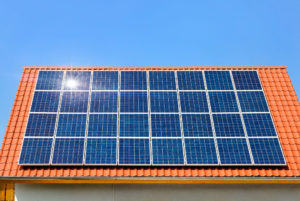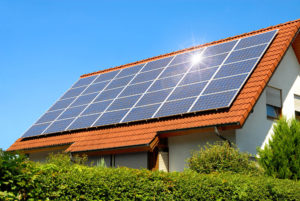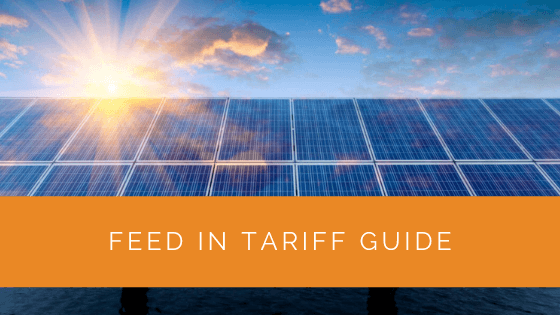Solar energy is one of the cleanest forms of energy. People across the globe are getting more environmentally conscious and opting to use renewable energy sources instead of traditional forms of electricity. It benefits them in many ways.
While solar energy helps reduce your carbon footprint, it is also financially lucrative for households and businesses. The government and commercial energy suppliers have recognised the use of solar panels in households, and they reward people monetarily through feed-in tariffs.
This acknowledgement serves as an incentive for people to switch to solar panels, too. People save money on energy bills and contribute to the planet’s welfare using renewable energy sources like solar panels and wind turbines.
If you are new to this, you might have difficulty understanding the Feed-in tariff regarding solar energy. Continue reading to learn more about this incentive most solar energy consumers are eligible for!
Contents
- 1 Key Takeaways
- 2 What is FIT or Feed in Tariff?
- 3 Who Can Benefit from The Feed-In Tariff (FIT) Scheme?
- 4 How Can I Be a Part of The Scheme?
- 5 What Is the Feed-In Tariff for Solar-Powered Electricity Production?
- 6 Case Study: Maximising Financial Benefits with the Feed-in Tariff Scheme
- 7 Expert Insights From Our Solar Panel Installers About Feed-in Tariffs
- 8 Discover the Power of Solar with Solar Panels Network
- 9 To Conclude With
Key Takeaways
- The Feed-in Tariff (FIT) program rewards individuals and businesses for using renewable energy sources like solar panels, wind turbines, and hydroelectricity. It encourages the adoption of clean energy and reduces the load on the grid.
- FIT offers payments in the form of Generation and Export Tariffs to those who generate and supply surplus electricity to the grid using renewable sources.
- Eligibility for FIT depends on the type of renewable energy source you use, and you must follow specific steps, including registration with Ofgem and obtaining necessary certifications, to benefit from the scheme. The amount received through FIT is based on the Energy Performance Certificate (EPC) grade and can last up to 20 years.
What is FIT or Feed in Tariff?
Feed-in tariff is essentially getting paid for using renewable sources of energy. Tariffs are paid to individuals or businesses that take the initiative to use solar energy in their homes or complexes. This method of electricity generation takes the load off the grid, making it a cleaner and more environmentally conscious option.
The FIT scheme was launched over a decade ago, in April 2010. Under this scheme, different payments are made to people just for using sustainable energy sources. The scheme has served as motivation for customers to get solar panel systems installed in their homes.
Here are a few additional payments made to people who opt for solar, hydro, or wind energy.
- Generation Tariff: Generation tariff is the amount paid to users per kWh of electricity they produce using solar panels. These payments are made even if people use the generated electricity for personal use.
- Export Tariff: An export tariff is rewarded to people who give surplus electricity to the grid to help take the load off. The amount given to people is fixed, and they are paid per kWh of electricity they end up supplying to the system.
Apart from this, people also save money on their electricity bill payments depending on how much they generate. Additionally, you can factor in the panels’ total cost, installation, and maintenance costs at first and then estimate how long it will take to make this money back!
People eligible to hand out Feed-in tariffs mentioned above can sanction them. Since April 2010, the FIT scheme has encouraged many people to join the program as its official licensees. These people generally work as energy suppliers and have access to data regarding solar energy numbers.
Licensed energy suppliers or any other official organisation can further oversee the distribution of the FIT scheme. The more licensees join the program, the larger its reach.

Who Can Benefit from The Feed-In Tariff (FIT) Scheme?
The feed-in tariff scheme was introduced to encourage people to use renewable energy sources. Tariff payments are made depending on the amount of electricity you generate using alternate means apart from the grid’s energy. The government has launched a list of things that make you eligible for the scheme.
People with the following sources can apply for compensation under the feed-in tariff (FIT) program.
- Solar panels or solar PV(roof-mounted or stand-alone)
- Wind turbines (building-mounted or free-standing)
- Hydroelectricity
- Anaerobic digesters for anaerobic digestion
- Micro combined heat and power (CHP)
When you compare the installation charges of solar panels to wind or hydroelectricity generation plants, you realise how cost-effective this option is. With solar energy, you can account for installations, maintenance, technical support, etc., and still get returns faster than you could imagine.
Anaerobic digestion and micro CHP are two energy-generation technologies that have been around for years but are not commonly seen in small households. Over the last 20 years, the FIT scheme has more popularised solar PV in households because of its installation costs and generation capacity!
How Can I Be a Part of The Scheme?
Getting yourself a solar panel is not enough if you want to be compensated for using solar energy in the form of electricity at home. Here are a few additional measures you need to take to be eligible for the FIT scheme. Additionally, you could pick between solar PV and non-PV when it comes to solar energy.b
- The post office needs to have your address registered and recognised.
- Total generation needs to be less than 5MW.
- All solar panel installers must have the necessary certification from the Microgeneration Certification Scheme (MCS) at installation. Regarding hydro or wind energy setups, you must reach out to ROO-FIT.
- You need to acquire an MCS certificate from the installer once he registers your solar panel set up on the central MCS database after installation.
Getting an MCS certificate from a licensed provider is the best way to ensure eligibility for this scheme. The process might seem tedious, but you should have no trouble making the most of these services if you follow the steps right.
You will be eligible for a feed-in tariff or FIT scheme (or ROO-FIT) after being registered on the Ofgem Central FIT Register by an official licensee. Once you register on the platform and your energy supplier recognises you will be eligible for payments from the government.
The process, however, is not that easy. Upon your Ofgem registration, you must provide the licensee with the MCS certification you possess and an image of your meter reading. This meter reading must be taken the day you submit your application.
Further, you must attach your setup invoice and add proof of ownership to complete the application and continue the process with Ofgem. After a proper evaluation of your solar panel setup-, an eligibility date will be agreed on before you benefit from the FIT payments.
After evaluation, you will receive an Energy Performance Certificate (EPC). If your rating is below a D, you will not receive the licensee’s standard kWh payment. Once registered and eligible for the feed-in tariff or FIT scheme, you will receive monetary benefits or support from the date you submit your meter reading.

What Is the Feed-In Tariff for Solar-Powered Electricity Production?
The licensees will assess renewable energy, and you will receive an EPC grade. The amount of tariff you get under the feed-in tariff or FIT scheme depends on this grade. However, once you are eligible for this scheme, you will receive your monetary award for the next 20 years.
Here’s what you can expect to be rewarded under the feed-in tariff or FIT scheme for generating solar energy and taking the load off the grid system. These include generation and export rates.
Generation tariff rates for solar setups- that generate power for households and commercial complexes.
| Technology Type | Installation Type | Minimum Capacity (kW) | Maximum Capacity (kW) | Energy efficiency Requirement Rating | Tariff | Start Date |
|---|---|---|---|---|---|---|
| Photovoltaic | New Build | 0 | 4 | Lower | 0.16 | 01-01-2019 |
| Photovoltaic | Standard | 4.001 | 10 | Lower | 0.16 | 01-01-2019 |
| Photovoltaic | Retrofit | 0 | 4 | Middle | 3.53 | 01-01-2019 |
| Photovoltaic | New Build | 0 | 4 | Middle | 3.53 | 01-01-2019 |
| Photovoltaic | Standard | 4.001 | 10 | Middle | 3.53 | 01-01-2019 |
| Photovoltaic | Retrofit | 0 | 4 | Higher | 3.92 | 01-01-2019 |
| Photovoltaic | New Build | 0 | 4 | Higher | 3.92 | 01-01-2019 |
| Photovoltaic | Standard | 4.001 | 10 | Higher | 3.92 | 01-01-2019 |
| Photovoltaic | Standard | 10.001 | 50 | Lower | 0.16 | 01-01-2019 |
| Photovoltaic | Standard | 10.001 | 50 | Middle | 3.75 | 01-01-2019 |
| Photovoltaic | Standard | 10.001 | 50 | Higher | 4.17 | 01-01-2019 |
| Photovoltaic | Standard | 50.001 | 250 | Lower | 0.16 | 01-01-2019 |
| Photovoltaic | Standard | 50.001 | 250 | Middle | 1.57 | 01-01-2019 |
| Photovoltaic | Standard | 50.001 | 250 | Higher | 1.75 | 01-01-2019 |
| Photovoltaic | Standard | 250.001 | 1000 | N/A | 1.38 | 01-01-2019 |
| Photovoltaic | Standard | 1000.001 | 5000 | N/A | 0.16 | 01-01-2019 |
| Photovoltaic | Standalone | 0 | 5000 | N/A | 0.05 | 01-01-2019 |
Meters are set up for a more accurate measure of the readings in systems with a more than 30 kWh capacity. You can contact your energy supplier and take their advice to learn more about your system meter and the amount of power you generate.
Case Study: Maximising Financial Benefits with the Feed-in Tariff Scheme
Background
At Solar Panels Network, we guide our clients in navigating the complexities of solar energy systems and maximising their financial benefits. This case study highlights a residential project where the homeowners leveraged the Feed-in Tariff (FIT) scheme to enhance the economic viability of their solar panel installation.
Project Overview
The homeowners, based in the South of England, installed a 4 kW solar photovoltaic (PV) system to reduce their energy bills and contribute to environmental sustainability. They sought to understand how to benefit from the FIT scheme, which offers payments for generating and exporting renewable electricity.
Implementation
- System Installation and Certification: The homeowners chose high-efficiency monocrystalline panels to maximise energy production. Our certified installers ensured the system met all standards required for MCS certification, which is essential for eligibility under the FIT scheme. The installation process included setting up an export meter to accurately measure the electricity fed back into the grid.
- FIT Registration Process: Once the system was installed and certified, we assisted the homeowners in registering with Ofgem’s Central FIT Register. This process involved submitting the MCS certificate, a photograph of the initial meter reading, and proof of ownership. The registration ensured they could receive both generation and export tariffs.
- Monitoring and Performance: To maximise the benefits from the FIT scheme, the system was equipped with a monitoring solution that allowed the homeowners to track their energy production and usage in real-time. This tool helped them optimise energy consumption, ensuring that the maximum possible surplus was exported to the grid.
Results
- Financial Rewards: Through the FIT scheme, the homeowners received payments for each kilowatt-hour (kWh) of electricity generated, as well as additional payments for the excess energy exported to the grid. Over the first year, they earned approximately £600 from generation tariffs and an additional £200 from export tariffs, significantly offsetting their initial investment.
- Energy Savings and Independence: The solar PV system produced enough electricity to cover around 70% of the household’s annual energy needs. The FIT payments and savings on electricity bills reduced the payback period of the system, making it a highly economical choice.
- Environmental Impact: By generating renewable energy, the homeowners reduced their carbon footprint by an estimated 1.5 tonnes of CO2 annually. This contribution supports broader environmental goals and reflects a commitment to sustainable living.
Summary
This case study demonstrates the substantial financial and environmental benefits of participating in the Feed-in Tariff scheme. The combination of generation and export tariffs provided a reliable income stream, while the solar PV system significantly reduced electricity costs. At Solar Panels Network, we continue to support our clients in navigating the complexities of renewable energy systems, ensuring they maximise their returns and contribute positively to the environment.
Expert Insights From Our Solar Panel Installers About Feed-in Tariffs
Feed-in tariffs are an excellent incentive for homeowners to adopt renewable energy sources like solar panels. They not only help reduce electricity costs but also offer a steady income stream for the surplus energy fed back into the grid.
Renewable Energy Consultant
One of the key benefits of the FIT scheme is its role in promoting energy independence. By generating your own electricity, you reduce your reliance on the grid, and the FIT payments provide a financial reward for your investment in clean energy.
Senior Solar Energy Specialist
To qualify for feed-in tariffs, it’s crucial that your solar panel installation is certified by the Microgeneration Certification Scheme (MCS). This certification ensures that your system meets the necessary standards to receive FIT payments.
Chief Installation Officer
Discover the Power of Solar with Solar Panels Network
Are you navigating the world of solar installations? Look no further than Solar Panels Network, the UK’s trusted partner in harnessing the sun’s potential. Our dedication goes beyond just installations; we’re on a mission to transform how homeowners and businesses across the UK perceive and utilise energy. By choosing us, you’re reducing your carbon footprint and making a smart financial move that promises savings for years ahead. Contact us today and embark on your solar journey.
To Conclude With
While saving electricity bills is exciting, making cash while powering your house is a different ball game. Customers who generated excess solar energy were certainly at a bigger advantage. Under the FIT scheme, customers can benefit from solar technologies in more ways than they imagined.
You can make the most of your installations by contacting your energy supplier today and learning more about FIT and its countless benefits!
About the Author
Solar Panels Network stands at the forefront of solar energy solutions, driven by a team of seasoned solar engineers and energy consultants. With over decades of experience in delivering high-quality solar installations and maintenance, we are committed to promoting sustainable energy through customer-centric, tailored solutions. Our articles reflect this commitment, crafted collaboratively by experts to provide accurate, up-to-date insights into solar technology, ensuring our readers are well-informed and empowered in their solar energy decisions.

